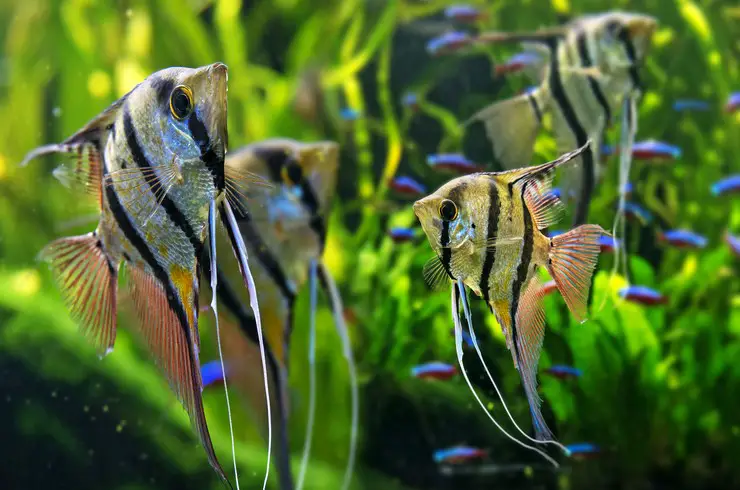Graceful scalars have won the hearts of millions of aquarists on our planet. An unusual crescent-shaped body, highly elongated fins, relative ease of maintenance, and a well-developed parental instinct are far from being a complete list of the positive aspects of scalars.
Aquarium for scalars
Currently, 3 types of scalar are known: ordinary, Leopold, and high fin (altum), the conditions of which are practically the same.
The scalar is a fairly territorial fish, so it is necessary to strive for a couple of adult fish to have at least 100 liters of water. And to contain a small group of scalars, much larger containers will be required. The height of the aquarium plays an important role, it is desirable that it be at least 50 cm, so you can enjoy all the charm of the scalar’s spread fins.
The aquarium should be equipped with a cover to prevent the fish from accidentally jumping onto the floor.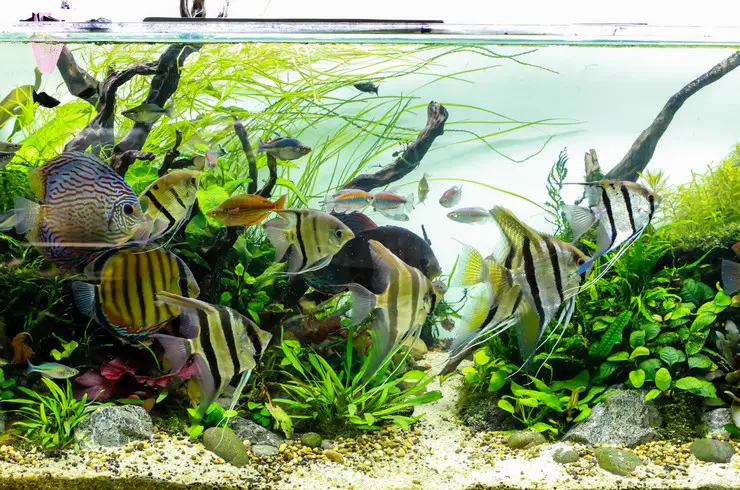
The natural style will be the best choice for decorating your scalar fish tank. Fish look great among natural driftwood in thickets of living plants. Young scalars live quietly in groups, but with age, they break up into pairs, one of which becomes the head of the hierarchy and proves its strength by arranging periodic skirmishes with neighbors. Natural decorations allow you to zone the aquarium when keeping several pairs of fish.
Maintaining proper water purity is an important point in the maintenance of scalars. The aquarium must be equipped with a productive filter (preferably an external one) and a compressor. Also, scalars prefer warm water, this will be helped by a modern thermostat, which in automatic mode will maintain a given comfortable temperature. To keep the altum scalar, the cost of which is ten times higher than ordinary ones, it is recommended to install an aquarium ultraviolet sterilizer for water disinfection.
The water flow in a fish tank should be moderate.
Water parameters
In nature, scalars live in the large rivers of the tropical part of South America – the Amazon, Orinoco. The water in these reservoirs is soft and acidic, due to the constant decomposition of leaves falling from trees in moist forests. The water is well warmed up by the sun and usually has a temperature of at least 24 ° C, only during the rainy season it drops to 18 ° C. Depending on the geographic area, the scalar can be found in both clear glasses of water and “dark water”.
Optimum water parameters for keeping scalars:
- Temperature: 24-28 ° С;
- Acidity (pH): 6.5-7.5;
- Hardness: 5-15.
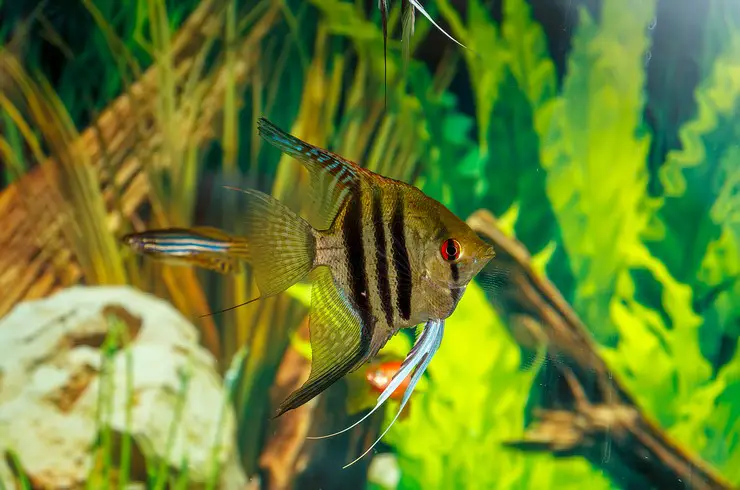
In the aquarium, you need to change 20% of the water for freshwater weekly. If you are using tap water, be sure to add Tetra AquaSafe conditioner before changing. It removes chlorine and its derivatives, binds heavy metals, enriches water with useful vitamins and colloids to protect mucous membranes. To keep the water safe, add 5 ml of fabric softener for every 10 liters of water you replace. This is a great alternative to sedimentation, which by itself only removes chlorine. And if you own a large aquarium, then the prospect of settling a huge amount of water for changes will not be at all bright.
Shine
Scalarians perfectly tolerate bright lighting, therefore, when choosing lamps for an aquarium with them, it is recommended to focus primarily on the needs of the living plants that will be planted. However, be sure to create some areas of medium and low light so that the fish can temporarily hide from the bright light.
Priming
The most suitable type of soil for scalars will be coarse quartz sand or small pebbles. Firstly, such soil is as close to natural as possible. Secondly, it is perfect for growing live plants. Thirdly, the delicate fins of the fish will not be injured when the fish go to bed and lie at the bottom. It is also worth noting the fact that digging is not an annoying habit of scalars.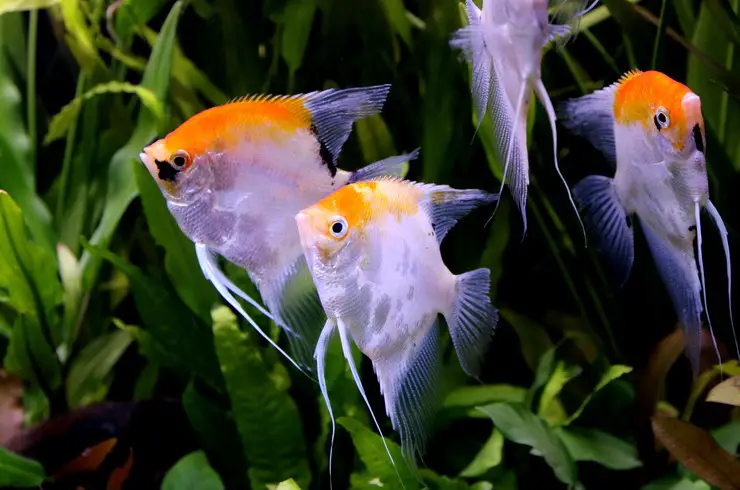
Plants
Plants in scalar aquariums are very important. Usually, they are planted along the walls, and open space for swimming is left in the center.
Long-stemmed plants (Ambulia, Vallisneria) and broad-leaved species – nymphs, echinoderms, cryptocorynes are perfect. The latter can become an excellent spawning substrate for fish. Various types of Eleocharis are often used as ground cover plants.
With a varied and sufficient diet, scalars are practically not interested in living plants in gastronomic terms.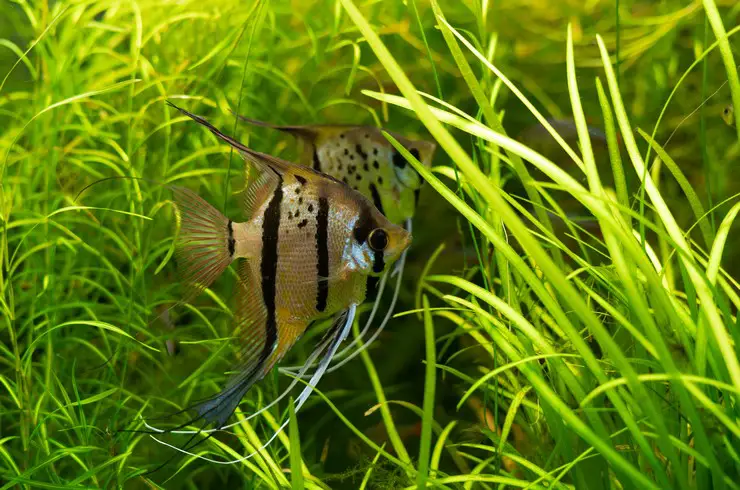
Feeding the scalar
It is best to feed the scalar at home with high-quality dry food. Live and frozen foods have a number of disadvantages such as imbalance and the potential for contamination of the aquarium.
Scalarians prefer to take food from the surface of the water or in its thickness, so flakes and chips, which slowly sink to the bottom, are best suited.
- TetraPro Energy – chips made using soft, gentle technology that allows you to preserve even more nutrients and vitamins. An additional source of energy in the center of each chip is a guarantee of the activity of graceful scalars.
- TetraMin is a universal flake food for all tropical fish. It is made from more than 40 types of raw materials and is perfect for the daily nutrition of fish. Contains a prebiotic for a comfortable digestion
- Natural delicacies Tetra FreshDelica – popular food organisms (bloodworms, daphnia, brine shrimp, krill) in nutritious jelly – will help you to diversify the scalar diet.
- And for scalars with red or yellow spots, feeds with natural carotenoids – TetraPro Color or Tetra Rubin Flakes, which enhance the natural color of the body, are useful.
Compatibility
Scalaria is one of the most peaceful cichlids, but, nevertheless, it is a predator and will easily swallow any fish that fits in its mouth. Therefore, when selecting neighbors, it is important to immediately weed out fish, the size of which is an adult state does not exceed 2 cm.
It is best to opt for large live-bearers (mollies, swordtails, platies), labyrinths (lalius and gourami), iris, peace-loving catfish (ancistrus, corridors). Various tetras, neons, minors will live well with scalars.
Do not combine scalar with active barbs (Sumatran, fire). There have been numerous cases of fishes biting the fins of scalars.
Big predatory fish and goldfish, which require a completely different temperature regime, will become bad neighbors.